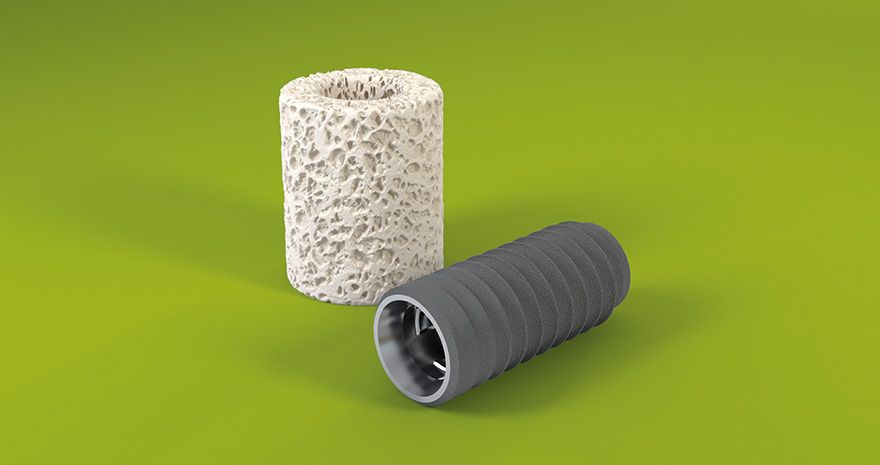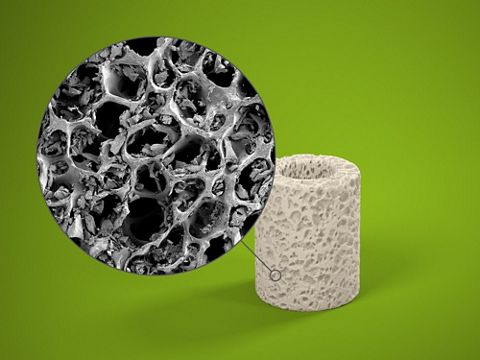Restoration of a 3D bony defect in region 46 with pre-fabricated allograft bone rings and simultaneous implantation
A clinical case report by Bernhard Giesenhagen, Germany
“The bone ring technique, as described in the following case report, has significant benefits over conventional procedures with autologous bone blocks: reduction in treatment time of between 45 and 60 minutes, avoidance of second procedure to harvest an autologous bone block and its associated risks, reduction of treatment time until the start of prosthetic restoration is reduced by three to six months.” (Dr. Bernhard Giesenhagen)
Initial situation
Male patient, 82 years old, non-smoker, with an unremarkable medical history. Previous clinical and radiographic diagnosis showed that teeth 44, 45, 46 and 47 were unrestorable and required extraction.
Treatment plan
The treatment plan included extractions, simultaneous bone augmentation using the maxgraft® bonering technique with pre-fabricated allografts, and immediate implantation with Straumann® Bone Level Implants at the tooth positions 44 and 46. A healing period of 6 months followed before final restoration with a 4-unit cantilever bridge.
“The use of the maxgraft® bonering technique is now established worldwide and offers an alternative to vertical augmentation with an autologous bone block. The success of this technique depends largely on compliance with the treatment protocol and good soft tissue management. If both criteria are met, the bone ring technique can be considered as a safe bone augmentation method for vertical defects.” Dr. Bernhard Giesenhagen
Surgical procedure
Once adequate local anaesthesia is achieved at the surgical site, teeth 44 to 47 are extracted (Fig. 1). The implant bed at tooth position 44 is then prepared and a Straumann® Bone Level Implant is placed at this site. The 46 position is subsequently prepared for the insertion of the maxgraft® bonering using instrumentation specifically designed for this technique (maxgraft® bonering surgical set). The size of the defect can be measured by using the trephine drill to determine the corresponding diameter of the bone ring. A bone ring with a diameter of 7.0 mm is required in position 46. The position and axis of the implant in the extraction site 46 is defined using a metal tulip drill and the ∅ 2.0 mm pilot bur. The ring bed is then prepared with the ∅ 7.0 mm trephine with pin. The pin has the same 2.0 mm diameter of the pilot bur so that the position of the trephine drill matches the planned implant position. The depth of the ring bed is determined by the vertical extent of the defect, with the corresponding markings on the trephine drill. Autogenous bone chips from the drilling procedure can be collected and used to fill any residual defect. The ring bed is smoothed with the scalar to achieve a completely uniform surface for the maxgraft® bonering. At the same time, this step serves to remove any cortical bone from the prepared site to provide a good nutritive blood supply to the bone ring. The bone level of the neighbouring teeth can be used as a reference for the vertical stop of the bone ring. If needed, the diamond disc from the surgical kit can be used to adjust the height of the maxgraft® bonering. The maxgraft® bonering should then be pressed into the bleeding prepared ring bed to ensure rapid vascularization (Fig. 2). Final implant bed preparation is carried out through the hole of the bone ring, and the implant is inserted through the maxgraft® bonering into the residual bone apically (Fig. 3). The primary stability of the maxgraft® bonering and the Straumann® Bone Level Implant is highly dependent on the maxgraft® bonering making full contact with the walls of the prepared ring bed, when pressed into the site. The implant should also be inserted approximately 3.0 mm deep into the residual natural bone apically. After placing the implant, the edges of the maxgraft® bonering must be smoothed using the diamond tulip bur to prevent perforation of the soft tissue. If threads are still exposed buccally after implantation in three-dimensional defects or if gaps remain, they should covered or filled with a particulate bone substitute material. We recommend a stable bone substitute material with low resorption properties (such as cerabone® with particle size 0.5 – 1.0 mm by botiss). This provides the bone ring with protection against rapid resorption. The augmentation is covered with a membrane which has a long barrier function (such as the Jason® membrane by botiss) to ensure undisturbed and stable healing. The site is then closed in a tension-free manner, which is crucial for the success of the procedure. The sutures are removed approximately. ten days postoperatively. Recommended post-operative medication: antibiotics (Clindamycin 600 mg per day for five days) and an analgestic (Sympal), if required.
Outcome/conclusion
Post-op x-ray images (Fig. 4) and six-month post-op (Fig. 5) show good healing at the site with no complications. Re-entry to the implant site was done after 6 months of healing and the final prosthetic restoration was completed. One year after loading of the implants, a stable osseous condition is still present (Fig. 6), with no inflammation of the soft tissue.


 bonering (a further development with Dr. Orcan Yüksel). Use of the maxgraft
bonering (a further development with Dr. Orcan Yüksel). Use of the maxgraft